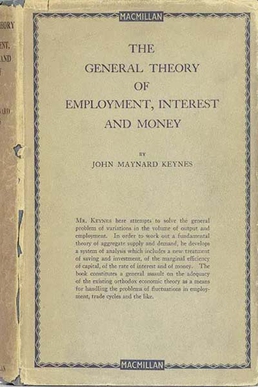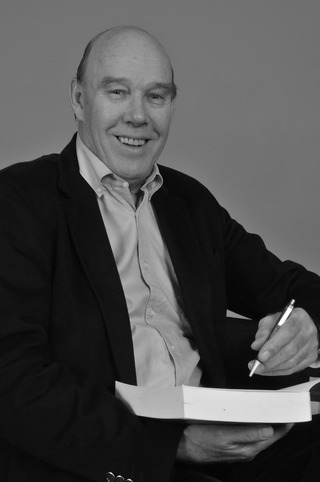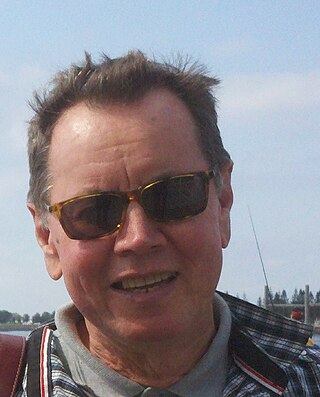Related Research Articles
Keynesian economics are the various macroeconomic theories and models of how aggregate demand strongly influences economic output and inflation. In the Keynesian view, aggregate demand does not necessarily equal the productive capacity of the economy. It is influenced by a host of factors that sometimes behave erratically and impact production, employment, and inflation.

John Maynard Keynes, 1st Baron Keynes, was an English economist and philosopher whose ideas fundamentally changed the theory and practice of macroeconomics and the economic policies of governments. Originally trained in mathematics, he built on and greatly refined earlier work on the causes of business cycles. One of the most influential economists of the 20th century, he produced writings that are the basis for the school of thought known as Keynesian economics, and its various offshoots. His ideas, reformulated as New Keynesianism, are fundamental to mainstream macroeconomics. He is known as the "father of macroeconomics".
Post-Keynesian economics is a school of economic thought with its origins in The General Theory of John Maynard Keynes, with subsequent development influenced to a large degree by Michał Kalecki, Joan Robinson, Nicholas Kaldor, Sidney Weintraub, Paul Davidson, Piero Sraffa and Jan Kregel. Historian Robert Skidelsky argues that the post-Keynesian school has remained closest to the spirit of Keynes' original work. It is a heterodox approach to economics.

The Stockholm School is a school of economic thought. It refers to a loosely organized group of Swedish economists that worked together, in Stockholm, Sweden primarily in the 1930s.

The General Theory of Employment, Interest and Money is a book by English economist John Maynard Keynes published in February 1936. It caused a profound shift in economic thought, giving macroeconomics a central place in economic theory and contributing much of its terminology – the "Keynesian Revolution". It had equally powerful consequences in economic policy, being interpreted as providing theoretical support for government spending in general, and for budgetary deficits, monetary intervention and counter-cyclical policies in particular. It is pervaded with an air of mistrust for the rationality of free-market decision making.

Alvin Harvey Hansen was an American economist who taught at the University of Minnesota and was later a chair professor of economics at Harvard University. Often referred to as "the American Keynes", he was a widely read popular author on economic issues, and an influential advisor to the government on economic policy. Hansen helped create the Council of Economic Advisors and the Social Security system. He is best remembered today for introducing Keynesian economics in the United States in the 1930s and 40s.
The history of economic thought is the study of the philosophies of the different thinkers and theories in the subjects that later became political economy and economics, from the ancient world to the present day.
The neoclassical synthesis (NCS), or neoclassical–Keynesian synthesis is an academic movement and paradigm in economics that worked towards reconciling the macroeconomic thought of John Maynard Keynes in his book The General Theory of Employment, Interest and Money (1936) with neoclassical economics.

Paul Davidson was an American macroeconomist who has been one of the leading spokesmen of the American branch of the post-Keynesian school in economics. He has actively intervened in important debates on economic policy from a position critical of mainstream economics.
Steven Pressman is an American economist. He is a former Professor of Economics and Finance at Monmouth University in West Long Branch, New Jersey. He has taught at the University of New Hampshire and Trinity College in Hartford, Connecticut.

The Keynesian Revolution was a fundamental reworking of economic theory concerning the factors determining employment levels in the overall economy. The revolution was set against the then orthodox economic framework, namely neoclassical economics.

Macroeconomic theory has its origins in the study of business cycles and monetary theory. In general, early theorists believed monetary factors could not affect real factors such as real output. John Maynard Keynes attacked some of these "classical" theories and produced a general theory that described the whole economy in terms of aggregates rather than individual, microeconomic parts. Attempting to explain unemployment and recessions, he noticed the tendency for people and businesses to hoard cash and avoid investment during a recession. He argued that this invalidated the assumptions of classical economists who thought that markets always clear, leaving no surplus of goods and no willing labor left idle.
Athanasios "Tom" Asimakopulos was a Canadian economist, who was the "William Dow Professor of Political Economy" in the Department of Economics, McGill University, Montreal, Quebec, Canada. His monograph, Keynes's General Theory and Accumulation, reviews important areas of Keynes's General Theory and the theories of accumulation of two of his most distinguished followers, Roy Harrod and Joan Robinson.

Basil John Moore was a Canadian post-Keynesian economist, best known for developing and promoting endogenous money theory, particularly the proposition that the money supply curve is horizontal, rather than upward sloping, a proposition known as horizontalism. He was the most vocal proponent of this theory, and is considered a central figure in post Keynesian economics

Anthony Philip Thirlwall was a British economist who was Professor of Applied Economics at the University of Kent. He made major contributions to regional economics; the analysis of unemployment and inflation; balance of payments theory, and to growth and development economics with particular reference to developing countries. He was the author of the bestselling textbook Economics of Development: Theory and Evidence now in its ninth edition. He was also the biographer and literary executor of the famous Cambridge economist Nicholas Kaldor. Perhaps his most notable contribution was to show that if long-run balance of payments equilibrium is a requirement for a country, its growth of national income can be approximated by the ratio of the growth of exports to the income elasticity of demand for imports.

Murray Milgate, is an Australian-born academic economist and Sometime Fellow and director of studies in economics at Queens' College in the University of Cambridge, where he is now a Life Fellow. He is the co-creator and co-editor of the celebrated original edition of The New Palgrave Dictionary of Economics (1987) together with John Eatwell and Peter Newman.
Victoria Chick was a Post Keynesian economist known for her essays on monetary theory, banking and methodology. Her writing on Keynes's General Theory made her one of the foremost interpreters of his work. After the 2008 banking crisis she coined a corollary to Gresham's Law, arguing that in orthodox economics "bad theory drives out good."
Edward J. Nell is an American economist and a former professor at the New School for Social Research. Nell was a member of the New School faculty from 1969 to 2014. He achieved the rank of Malcolm B. Smith Professor of Economics in 1990.
The principle of effective demand is that the aggregate demand function and the aggregate supply function intersect each other at the point of effective demand and that this point can be consistent with a state of under-employment and under-capacity utilization. Another way of expressing this, in pre-Keynesian terminology, is to say that "demand creates its own supply" which gives primacy to a shifting demand function that can be insufficient to give an economy full employment in the long term, in contrast to Say's law which insists "supply creates its own demand" and doesn't allow the possibility of long term unemployment as the supply figure is always, by definition, a fixed amount that demand will match.
Marxism and Keynesianism is a method of understanding and comparing the works of influential economists John Maynard Keynes and Karl Marx. Both men's works has fostered respective schools of economic thought that have had significant influence in various academic circles as well as in influencing government policy of various states. Keynes' work found popularity in developed liberal economies following the Great Depression and World War II, most notably Franklin D. Roosevelt's New Deal in the United States in which strong industrial production was backed by strong unions and government support. Marx's work, with varying degrees of faithfulness, led the way to a number of socialist states, notably the Soviet Union and the People's Republic of China. The immense influence of both Marxian and Keynesian schools has led to numerous comparisons of the work of both economists along with synthesis of both schools.
References
- ↑ "Mark Hayes obituary". The Guardian. 12 March 2020. Retrieved 4 April 2020.
- ↑ "Dr M G Hayes". 28 October 2019.
- ↑ "Mark Hayes | PKES".
- ↑ Shared Interest
- ↑ Osborne, Sue (2010) Shared Interest: Investing in a Fairer World, Newcastle upon Tyne: Shared Interest ISBN 978-1-906477-35-6.
- ↑ Osborne, Sue (2010) Shared Interest: Investing in a Fairer World, Newcastle upon Tyne: Shared Interest ISBN 978-1-906477-35-6.
- ↑ "Heart of gold, feet of clay?". TheGuardian.com . 28 March 2004.
- ↑ Helen Potter Award
- ↑ Hayes, M. G. (2006) On the efficiency of Fair Trade, Review of Social Economy, 64 (4), 447–68
- ↑ "Centre for Catholic Studies".
- ↑ "John Maynard Keynes". 27 March 2016.